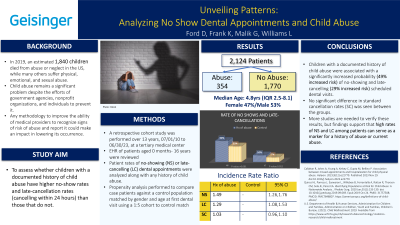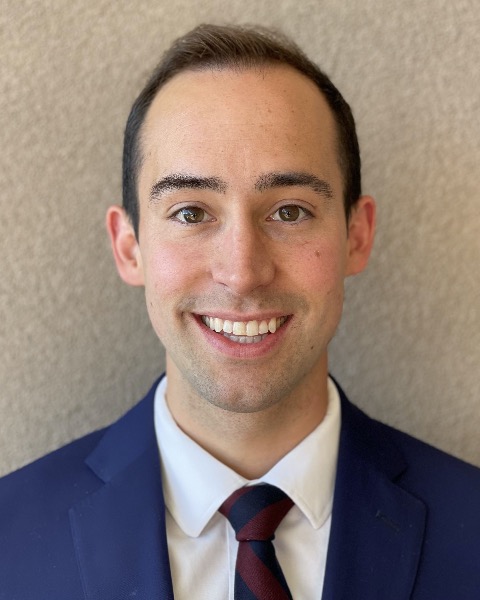Other
210 - Unveiling Patterns: Analyzing No Show Dental Appointments and Child Abuse


Daniel Ford, DDS (he/him/his)
Resident
Geisinger Pediatric Dentistry
Geisinger Health System
Danville, Utah, United States- KF
Katie Frank, MS
Geisinger Medical Center
- GM
Gayatri Malik, DMD
Geisigner Medical Center
- LW
Lacey N. Williams, DMD
Attending Physician
Geisinger Pediatric Dentistry
Geisinger Medical Center
Danville, Pennsylvania, United States - NS
Natalie Stinton, DMD
Program Director
Geisigner Pediatric Dentistry
Danville, Pennsylvania, United States
Presenting Author(s)
Co-Author(s)
Co-Author(s)
Research Mentor(s)
Program Director(s)
Purpose: This 13-year retrospective analysis aimed to compare the relationship between the history of child abuse and “no-showing” (NS) or “late-canceling” (LC)(canceling within 24 hours) dental visits.
Methods: An electronic health retrospective review of patient data from 07/01/13 to 06/30/23 was performed at a tertiary medical center to review patients with NS and LC rates along with any history of child abuse. Dental patients, 0 months to 16 years, with a history of documented abuse were reviewed alongside a control population matched by age, gender, and first dental visit using a 1:5 cohort to control the match.
Results: A total of 354 patients with a documented history of child abuse [Age-Median(IQR)= 4.9 (2.5, 8.3); Female=47%] and 1,770 patients with no history of child abuse [Age-Median(IQR)= 4.9 (2.5, 8.2); Female=47%] were reviewed. Patients with a history of abuse had significantly higher NS amounts and rates compared to control patients (1.10 vs 0.76 and 31% vs 23%; P < .001) and significantly higher LC amounts and rates compared to control patients (0.61 vs 0.46 and 10% vs 7%; P=.012).They also had significantly higher adjusted incident rate ratios of NS and LC compared to control patients (1.49:1 and 1.29:1; 95%CI), but no difference was found in standard cancellations (SC) between groups (1.03:1).
Conclusions: Patients with a history of documented child abuse have a higher rate and amount of NS and LC dental visits than those without this history, suggesting a correlation between the two. More research must be completed to corroborate these findings further.
Identify Supporting Agency and Grant Number:
Research supported by Geisinger Medical Center

.jpg)